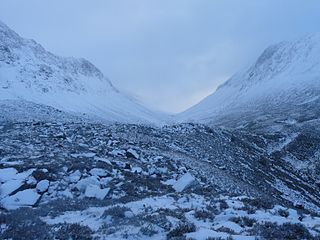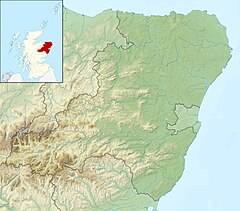
Hiberno-English or Irish English, also formerly Anglo-Irish, is the set of English dialects native to the island of Ireland.

Scottish Gaelic, also known as Scots Gaelic and Gaelic, is a Goidelic language native to the Gaels of Scotland. As a Goidelic language, Scottish Gaelic, as well as both Irish and Manx, developed out of Old Irish. It became a distinct spoken language sometime in the 13th century in the Middle Irish period, although a common literary language was shared by the Gaels of both Ireland and Scotland until well into the 17th century. Most of modern Scotland was once Gaelic-speaking, as evidenced especially by Gaelic-language place names.
A diphthong, also known as a gliding vowel, is a combination of two adjacent vowel sounds within the same syllable. Technically, a diphthong is a vowel with two different targets: that is, the tongue moves during the pronunciation of the vowel. In most varieties of English, the phrase "no highway cowboy" has five distinct diphthongs, one in every syllable.

Doric, the popular name for Mid Northern Scots or Northeast Scots, refers to the Scots language as spoken in the northeast of Scotland. There is an extensive body of literature, mostly poetry, ballads, and songs, written in Doric. In some literary works, Doric is used as the language of conversation while the rest of the work is in Lallans Scots or British English. A number of 20th and 21st century poets have written poetry in the Doric dialect.
The phonology of the open back vowels of the English language has undergone changes both overall and with regional variations, through Old and Middle English to the present. The sounds heard in modern English were significantly influenced by the Great Vowel Shift, as well as more recent developments in some dialects such as the cot–caught merger.
Scottish English is the set of varieties of the English language spoken in Scotland. The transregional, standardised variety is called Scottish Standard English or Standard Scottish English (SSE). Scottish Standard English may be defined as "the characteristic speech of the professional class [in Scotland] and the accepted norm in schools". IETF language tag for "Scottish Standard English" is en-scotland.

The River Dee is a river in Aberdeenshire, Scotland. It rises in the Cairngorms and flows through southern Aberdeenshire to reach the North Sea at Aberdeen. The area it passes through is known as Deeside, or Royal Deeside in the region between Braemar and Banchory because Queen Victoria came for a visit there in 1848 and greatly enjoyed herself. She and her husband, Prince Albert, built Balmoral Castle there which replaced an older castle.
Braemar is a village in Aberdeenshire, Scotland, around 58 miles (93 km) west of Aberdeen in the Highlands. It is the closest significantly-sized settlement to the upper course of the River Dee, sitting at an elevation of 339 metres (1,112 ft).
"I before E, except after C" is a mnemonic rule of thumb for English spelling. If one is unsure whether a word is spelled with the digraph ei or ie, the rhyme suggests that the correct order is ie unless the preceding letter is c, in which case it may be ei.
English phonology is the system of speech sounds used in spoken English. Like many other languages, English has wide variation in pronunciation, both historically and from dialect to dialect. In general, however, the regional dialects of English share a largely similar phonological system. Among other things, most dialects have vowel reduction in unstressed syllables and a complex set of phonological features that distinguish fortis and lenis consonants.

Aboyne is a village on the edge of the Highlands in Aberdeenshire, Scotland, on the River Dee, approximately 26 miles (42 km) west of Aberdeen. It has a swimming pool at Aboyne Academy, all-weather tennis courts, a bowling green and is home to the oldest 18 hole golf course on Royal Deeside. Aboyne Castle and the Loch of Aboyne are nearby.

The Lairig Ghru is one of the mountain passes through the Cairngorms of Scotland. The route and mountain pass partially lies on the Mar Lodge Estate.

Aberdeenshire or the County of Aberdeen is a historic county and registration county of Scotland. The area of the county, excluding the city of Aberdeen itself, is also a lieutenancy area. The county borders Kincardineshire, Angus and Perthshire to the south, Inverness-shire and Banffshire to the west, and the North Sea to the north and east. It has a coast-line of 65 miles (105 km). The county gives its name to the modern Aberdeenshire council area, which covers a larger area than the historic county.

Alford is a large village in Aberdeenshire, north-east Scotland, lying just south of the River Don. It lies within the Howe of Alford which occupies the middle reaches of the River Don.
Inverey is a hamlet on Mar Lodge Estate, in Aberdeenshire, Scotland.

Mar Lodge Estate is a highland estate in western Aberdeenshire, Scotland, which has been owned and managed by the National Trust for Scotland (NTS) since 1995. Its principal building, Mar Lodge, is about 4 miles (6.4 km) west of the village of Braemar. The estate is recognised as one of the most important nature conservation landscapes in the British Isles and occupies nearly 8% of the Cairngorms National Park, covering 29,340 hectares. The natural heritage value of the estate is reflected by the fact that much of it is designated as a Site of Special Scientific Interest (SSSI), a Special Area of Conservation (SAC) and a Special Protection Area (SPA). The entire estate has been classified as a national nature reserve since May 2017, and is designated a Category II protected area by the International Union for Conservation of Nature.

Irish, also known as Gaelic, is a Goidelic language of the Insular Celtic branch of the Celtic language family, which is a part of the Indo-European language family. Irish is indigenous to the island of Ireland and was the population's first language until the 19th century, when English gradually became dominant, particularly in the last decades of the century. Today, Irish is still commonly spoken as a first language in areas of Ireland collectively known as the Gaeltacht, in which only 2% of Ireland's population lived in 2016. It is also spoken by a larger group of habitual but non-traditional speakers, mostly in urban areas where the majority are second-language speakers.

There is no standard variety of Scottish Gaelic; although statements below are about all or most dialects, the north-western dialects are discussed more than others as they represent the majority of speakers.
Barrovian is an accent and dialect of English found in Barrow-in-Furness and several outlying settlements in Cumbria, England, historically in the county of Lancashire. Although a member of the Cumbrian dialect, The Barrovian and south Cumbria accent has a lot in common with the dialect of northern Lancashire, particularly the Lancaster/Morecambe area.
Sean, also spelled Seán or Séan in Irish English, is a male given name of Irish origin. It comes from the Irish versions of the Biblical Hebrew name Yohanan, Seán and Séan, rendered John in English and Johannes/Johann/Johan in other Germanic languages. The Norman French Jehan is another version.










